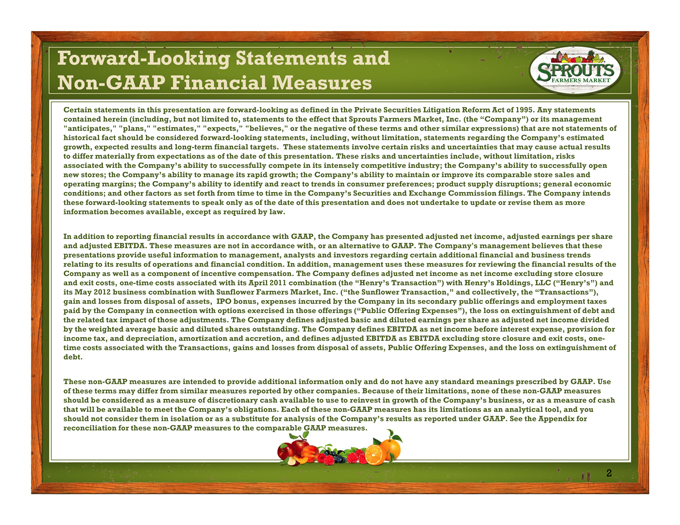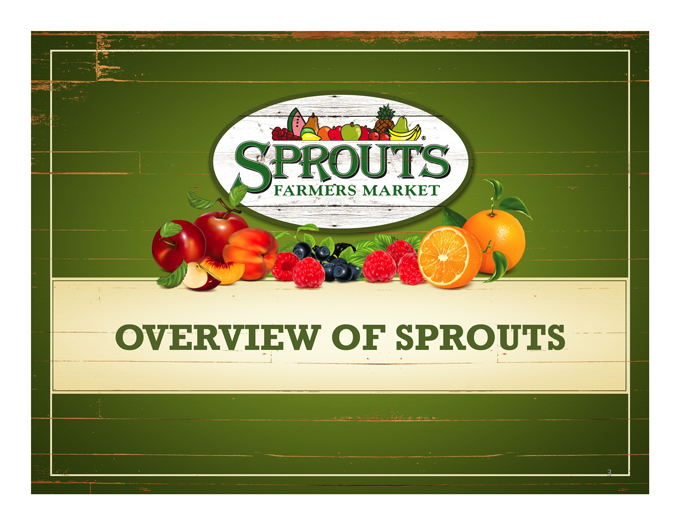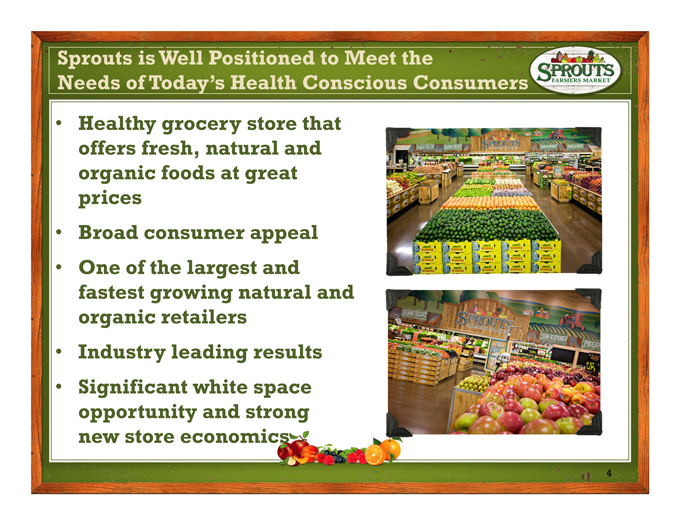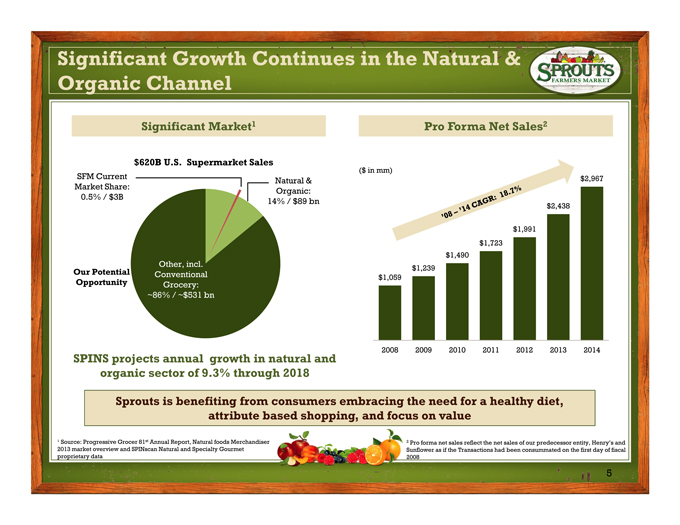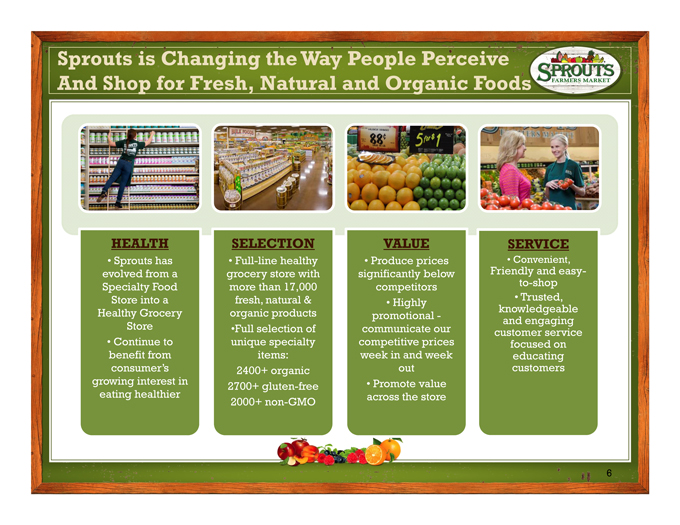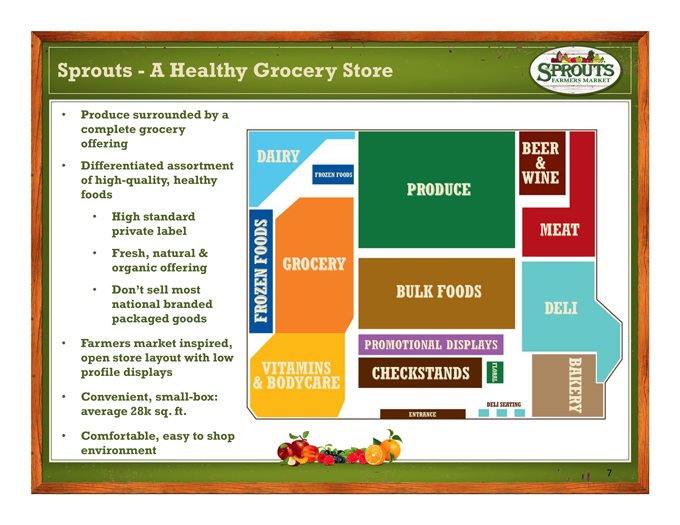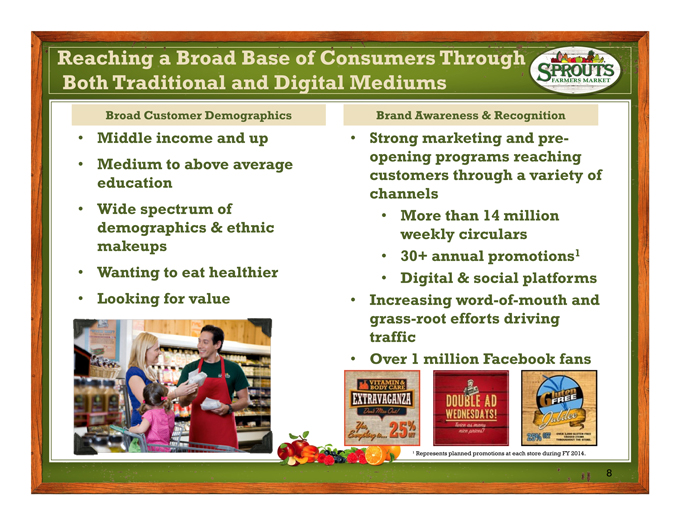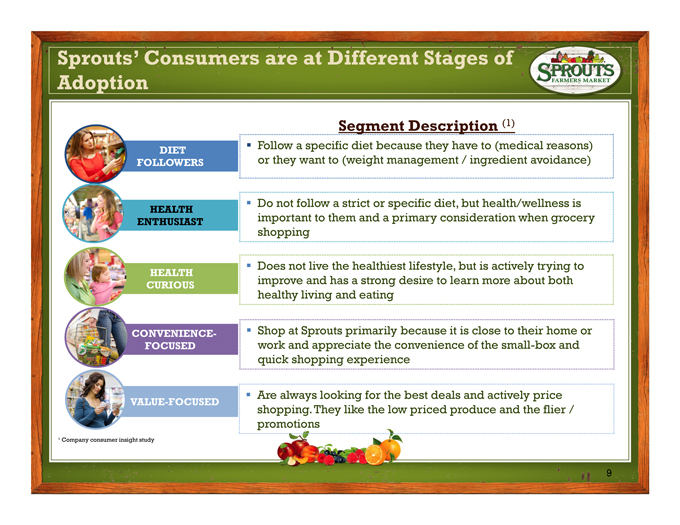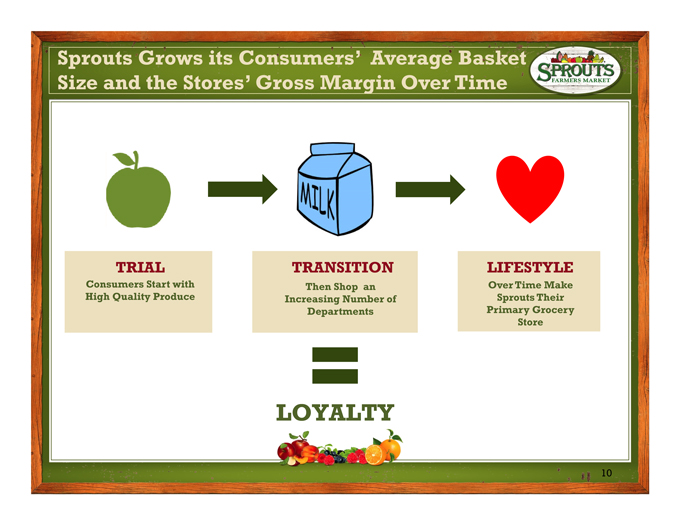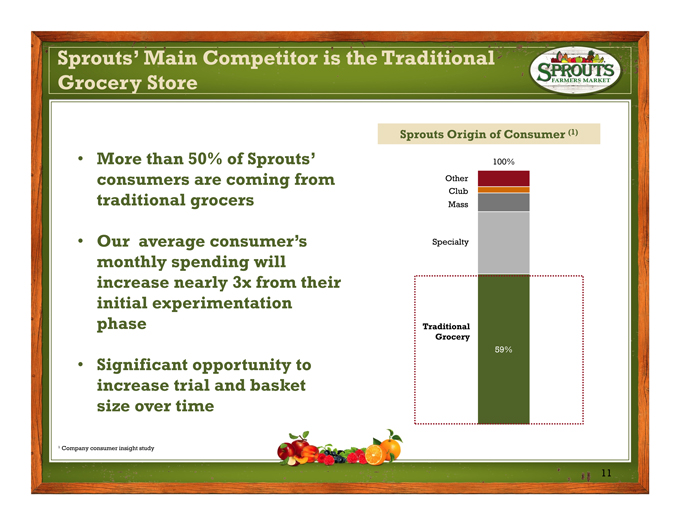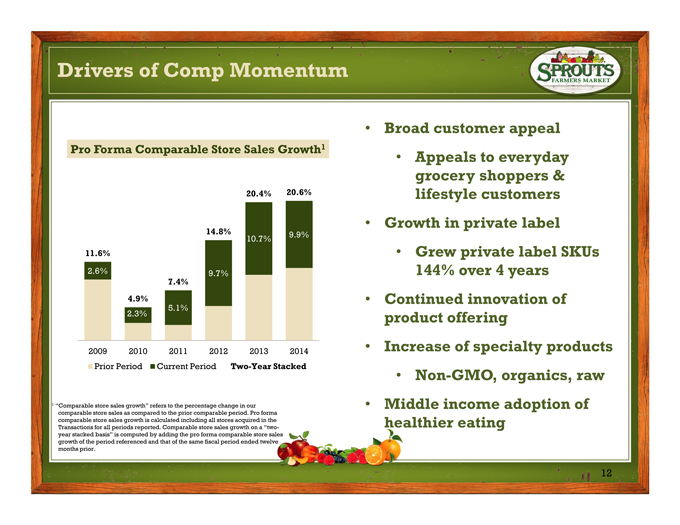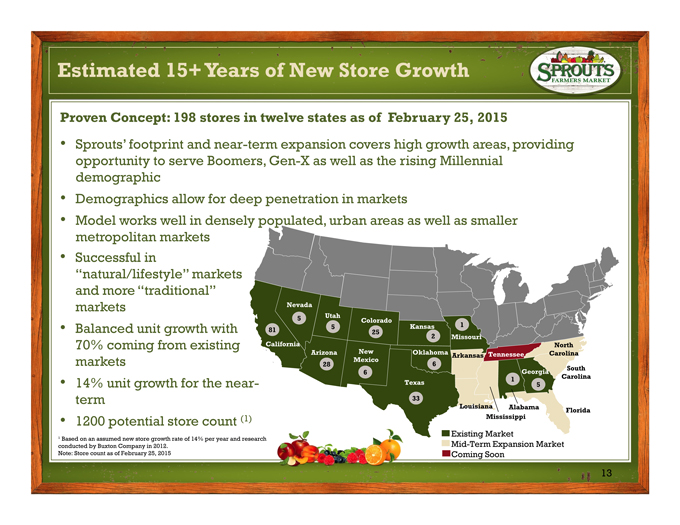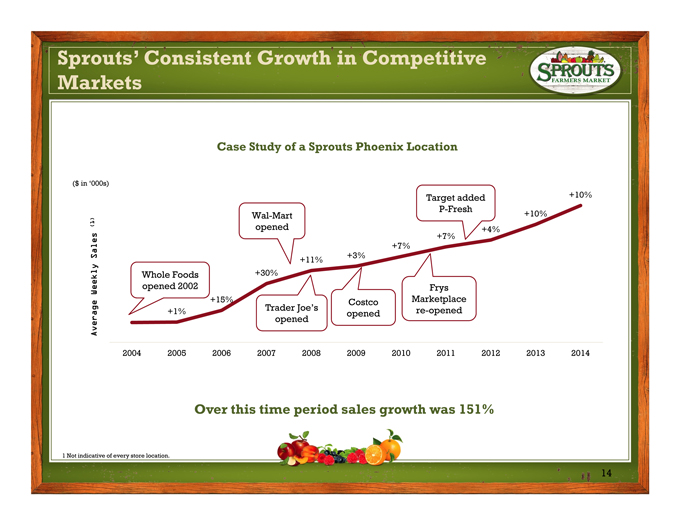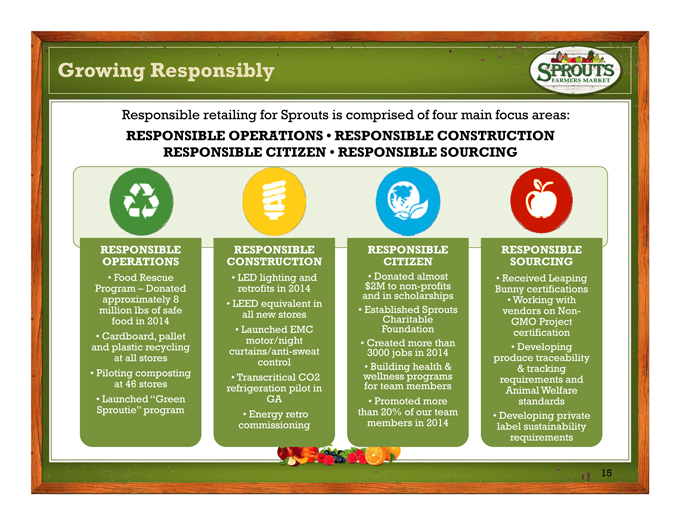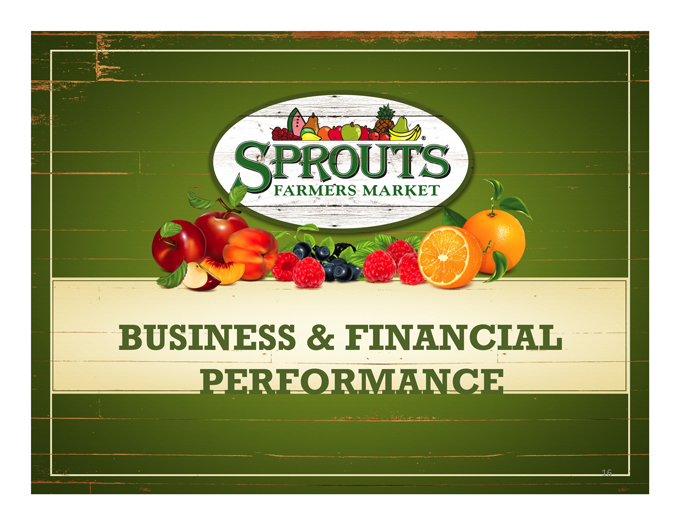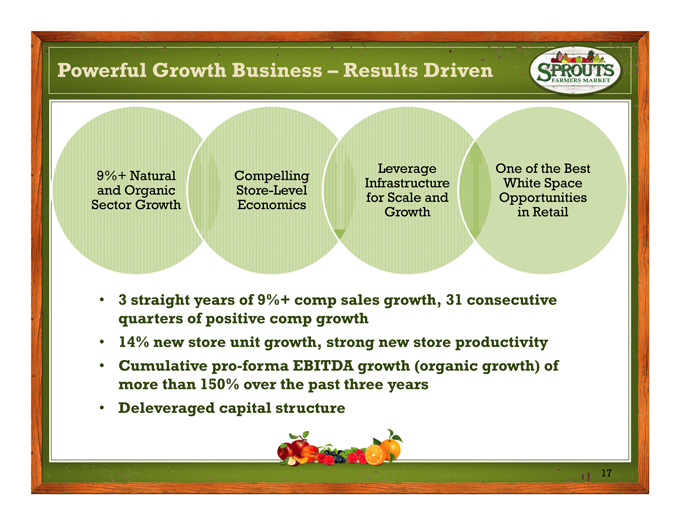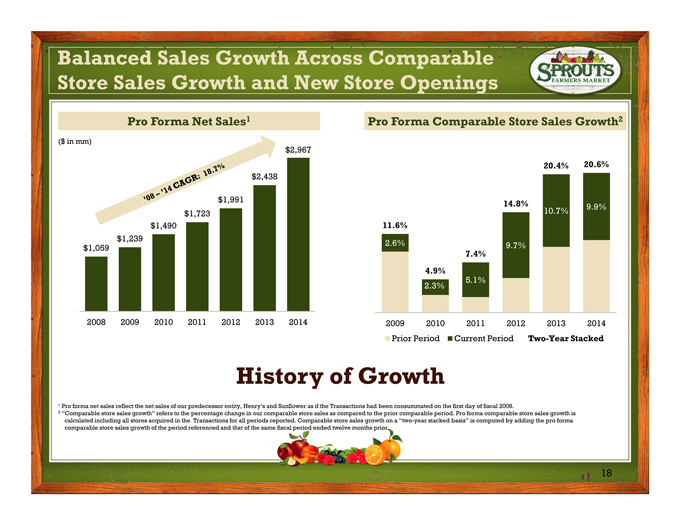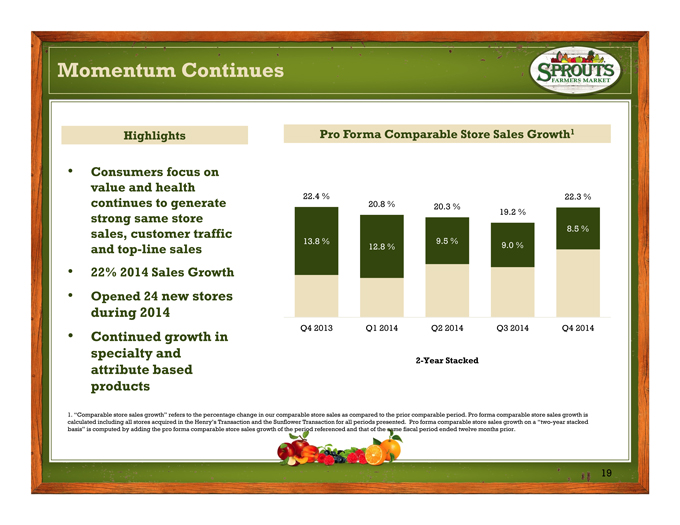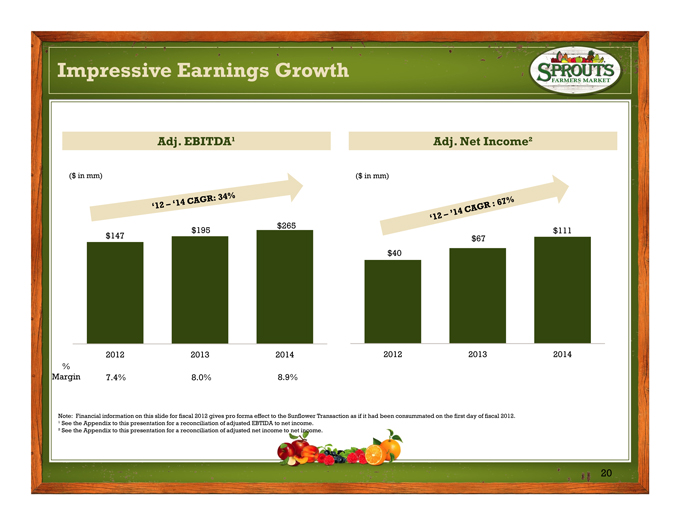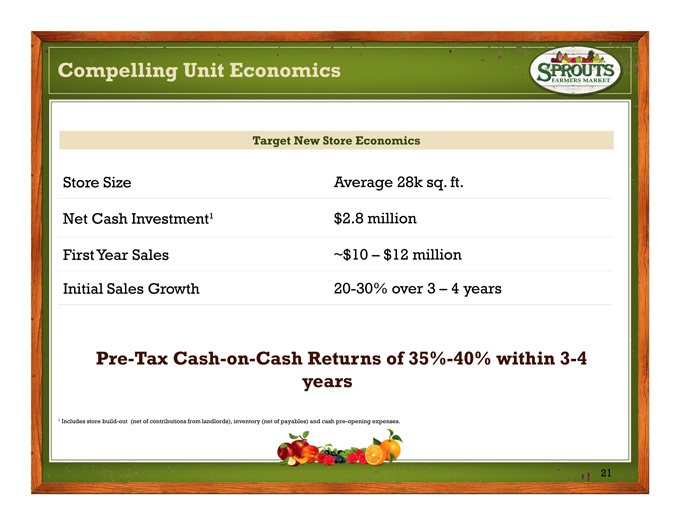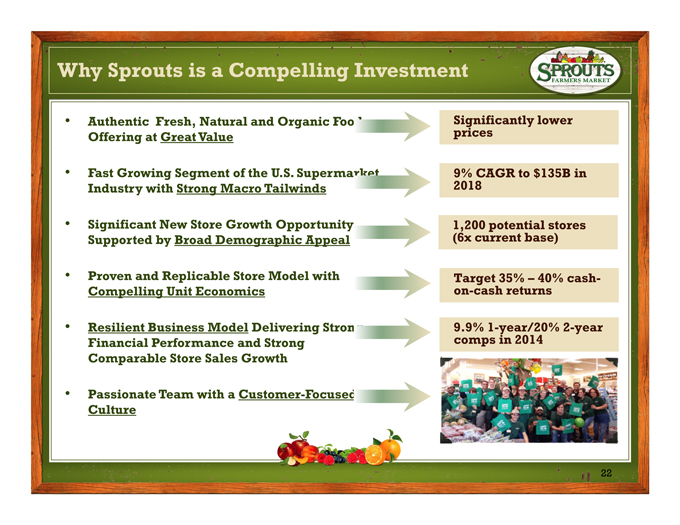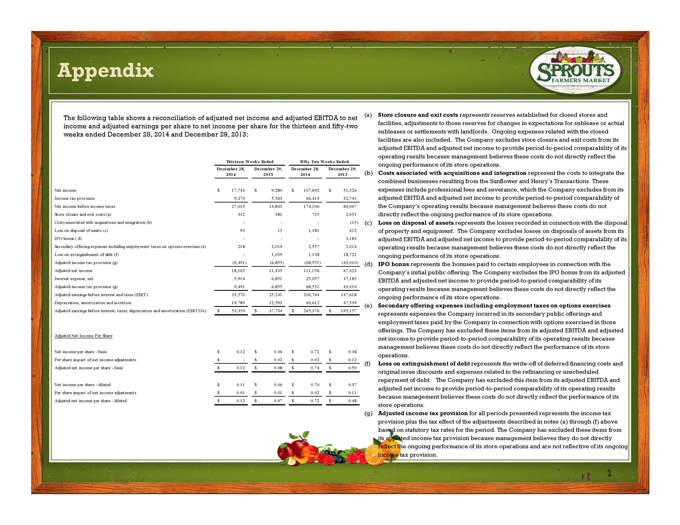|
Exhibit 99.1 
|
INVESTOR DECK March 2015
Forward-Looking Statements and Non-GAAP Financial Measures
Certain statements in this presentation are forward-looking as defined in the Private Securities Litigation Reform Act of 1995. Any statements contained herein (including, but not limited to, statements to the effect that Sprouts Farmers Market, Inc. (the “Company”) or its management “anticipates,” “plans,” “estimates,” “expects,” “believes,” or the negative of these terms and other similar expressions) that are not statements of historical fact should be considered forward-looking statements, including, without limitation, statements regarding the Company’s estimated growth, expected results and long-term financial targets. These statements involve certain risks and uncertainties that may cause actual results to differ materially from expectations as of the date of this presentation. These risks and uncertainties include, without limitation, risks associated with the Company’s ability to successfully compete in its intensely competitive industry; the Company’s ability to successfully open new stores; the Company’s ability to manage its rapid growth; the Company’s ability to maintain or improve its comparable store sales and operating margins; the Company’s ability to identify and react to trends in consumer preferences; product supply disruptions; general economic conditions; and other factors as set forth from time to time in the Company’s Securities and Exchange Commission filings. The Company intends these forward-looking statements to speak only as of the date of this presentation and does not undertake to update or revise them as more information becomes available, except as required by law.
In addition to reporting financial results in accordance with GAAP, the Company has presented adjusted net income, adjusted earnings per share and adjusted EBITDA. These measures are not in accordance with, or an alternative to GAAP. The Company’s management believes that these presentations provide useful information to management, analysts and investors regarding certain additional financial and business trends relating to its results of operations and financial condition. In addition, management uses these measures for reviewing the financial results of the Company as well as a component of incentive compensation. The Company defines adjusted net income as net income excluding store closure and exit costs, one-time costs associated with its April 2011 combination (the “Henry’s Transaction”) with Henry’s Holdings, LLC (“Henry’s”) and its May 2012 business combination with Sunflower Farmers Market, Inc. (“the Sunflower Transaction,” and collectively, the “Transactions”), gain and losses from disposal of assets, IPO bonus, expenses incurred by the Company in its secondary public offerings and employment taxes paid by the Company in connection with options exercised in those offerings (“Public Offering Expenses”), the loss on extinguishment of debt and the related tax impact of those adjustments. The Company defines adjusted basic and diluted earnings per share as adjusted net income divided by the weighted average basic and diluted shares outstanding. The Company defines EBITDA as net income before interest expense, provision for income tax, and depreciation, amortization and accretion, and defines adjusted EBITDA as EBITDA excluding store closure and exit costs, onetime costs associated with the Transactions, gains and losses from disposal of assets, Public Offering Expenses, and the loss on extinguishment of debt.
These non-GAAP measures are intended to provide additional information only and do not have any standard meanings prescribed by GAAP. Use of these terms may differ from similar measures reported by other companies. Because of their limitations, none of these non-GAAP measures should be considered as a measure of discretionary cash available to use to reinvest in growth of the Company’s business, or as a measure of cash that will be available to meet the Company’s obligations. Each of these non-GAAP measures has its limitations as an analytical tool, and you should not consider them in isolation or as a substitute for analysis of the Company’s results as reported under GAAP. See the Appendix for reconciliation for these non-GAAP measures to the comparable GAAP measures.
OVERVIEW OF SPROUTS
Sprouts is Well Positioned to Meet the
Needs of Today’s Health Conscious Consumers
Healthy grocery store that offers fresh, natural and organic foods at great prices Broad consumer appeal One of the largest and fastest growing natural and organic retailers Industry leading results Significant white space opportunity and strong new store economics
Significant Growth Continues in the Natural & Organic Channel
Significant Market1
$620B U.S. Supermarket Sales
SFM Current
Natural & Market Share: Organic: 0.5% / $3B
14% / $89 bn
Our Potential Other, incl.
Opportunity Conventional Grocery:
~86% / ~$531 bn
SPINS projects annual growth in natural and organic sector of 9.3% through 2018
Pro Forma Net Sales2
($ in mm) $2,967
$2,438
$1,991 $1,723 $1,490 $1,239 $1,059
2008 2009 2010 2011 2012 2013 2014
Sprouts is benefiting from consumers embracing the need for a healthy diet, attribute based shopping, and focus on value
¹ Source: Progressive Grocer 81st Annual Report, Natural foods Merchandiser 2013 market overview and SPINscan Natural and Specialty Gourmet proprietary data
2 Pro forma net sales reflect the net sales of our predecessor entity, Henry’s and Sunflower as if the Transactions had been consummated on the first day of fiscal 2008
Sprouts is Changing the Way People Perceive And Shop for Fresh, Natural and Organic Foods
HEALTH
Sprouts has evolved from a Specialty Food Store into a Healthy Grocery Store
Continue to benefit from consumer’s growing interest in eating healthier
SELECTION
Full-line healthy grocery store with more than 17,000 fresh, natural & organic products Full selection of unique specialty items: 2400+ organic 2700+ gluten-free 2000+ non-GMO
VALUE
Produce prices significantly below competitors
Highly promotional -communicate our competitive prices week in and week out
Promote value across the store
SERVICE
Convenient,
Friendly and easy-to-shop
Trusted, knowledgeable and engaging customer service focused on educating customers
Sprouts—A Healthy Grocery Store
Produce surrounded by a complete grocery offering Differentiated assortment of high-quality, healthy foods
High standard private label Fresh, natural & organic offering Don’t sell most national branded packaged goods
Farmers market inspired, open store layout with low profile displays Convenient, small-box: average 28k sq. ft. Comfortable, easy to shop environment
Reaching a Broad Base of Consumers Throughhrough Both Traditional and Digital Mediums
Broad Customer Demographics
Middle income and up Medium to above average education Wide spectrum of demographics & ethnic makeups Wanting to eat healthier Looking for value
Brand Awareness & Recognition
Strong marketing and pre-opening programs reaching customers through a variety of channels
More than 14 million weekly circulars 30+ annual promotions1 Digital & social platforms
Increasing word-of-mouth and grass-root efforts driving traffic Over 1 million Facebook fans
¹ Represents planned promotions at each store during FY 2014.
Sprouts’ Consumers are at Different Stages of Adoption
DIET FOLLOWERS
HEALTH ENTHUSIAST
HEALTH CURIOUS
CONVENIENCE-FOCUSED
VALUE-FOCUSED
¹ Company consumer insight study
Segment Description (1)
Follow a specific diet because they have to (medical reasons) or they want to (weight management / ingredient avoidance)
Do not follow a strict or specific diet, but health/wellness is important to them and a primary consideration when grocery shopping
Does not live the healthiest lifestyle, but is actively trying to improve and has a strong desire to learn more about both healthy living and eating
Shop at Sprouts primarily because it is close to their home or work and appreciate the convenience of the small-box and quick shopping experience
Are always looking for the best deals and actively price shopping. They like the low priced produce and the flier / promotions
9
Sprouts Grows its Consumers’ Average Basket Size and the Stores’ Gross Margin Over Time
TRIAL TRANSITION LIFESTYLE
Consumers Start with Then Shop an Over Time Make High Quality Produce Increasing Number of Sprouts Their Departments Primary Grocery Store
LOYALTY
10
Sprouts’ Main Competitor is the Traditional Grocery Store
More than 50% of Sprouts’ consumers are coming from traditional grocers
Our average consumer’s monthly spending will increase nearly 3x from their initial experimentation phase
Significant opportunity to increase trial and basket size over time
¹ Company consumer insight study
Sprouts Origin of Consumer (1)
100% Other Club Mass
Specialty
Traditional Grocery
59%
11
Drivers of Comp Momentum
Pro Forma Comparable Store Sales Growth1
20.4% 20.6%
14.8% 9.9%
10.7%
11.6%
2.6% 9.7%
7.4% 4.9%
5.1% 2.3%
2009 2010 2011 2012 2013 2014 Prior Period Current Period Two-Year Stacked
1 “Comparable store sales growth” refers to the percentage change in our comparable store sales as compared to the prior comparable period. Pro forma comparable store sales growth is calculated including all stores acquired in the Transactions for all periods reported. Comparable store sales growth on a “two-year stacked basis” is computed by adding the pro forma comparable store sales growth of the period referenced and that of the same fiscal period ended twelve months prior.
Broad customer appeal
Appeals to everyday grocery shoppers & lifestyle customers
Growth in private label
Grew private label SKUs 144% over 4 years
Continued innovation of product offering Increase of specialty products
Non-GMO, organics, raw
Middle income adoption of healthier eating
12
Estimated 15+ Years of New Store Growth
Proven Concept: 198 stores in twelve states as of February 25, 2015
Sprouts’ footprint and near-term expansion covers high growth areas, providing opportunity to serve Boomers, Gen-X as well as the rising Millennial demographic Demographics allow for deep penetration in markets Model works well in densely populated, urban areas as well as smaller metropolitan markets
Successful in
“natural/lifestyle” markets and more “traditional” markets Balanced unit growth with 70% coming from existing markets 14% unit growth for the near-term 1200 potential store count (1)
¹ Based on an assumed new store growth rate of 14% per year and research conducted by Buxton Company in 2012.
Note: Store count as of February 25, 2015
Nevada
5 Utah
Colorado
5 Kansas 1
81 25 2
Missouri
California North Arizona New Oklahoma Tennessee Carolina Arkansas Mexico
28 6
South
6 Georgia
1 Carolina Texas 5 33 Louisiana Alabama Mississippi Florida
Existing Market
Mid-Term Expansion Market Coming Soon
13
Sprouts’ Consistent Growth in Competitive Markets
Case Study of a Sprouts Phoenix Location
($ in ‘000s)
Target added +10% P-Fresh Wal-Mart +10% (1) opened
+4% +7% +7%
Sales +3%
+11%
Whole Foods +30%
Weekly opened 2002 Frys +15% Costco Marketplace +1% Trader Joe’s re-opened opened
Average opened
2004 2005 2006 2007 2008 2009 2010 2011 2012 2013 2014
Over this time period sales growth was 151%
1 | | Not indicative of every store location. |
14
Growing Responsibly
Responsible retailing for Sprouts is comprised of four main focus areas:
RESPONSIBLE OPERATIONS • RESPONSIBLE CONSTRUCTION RESPONSIBLE CITIZEN • RESPONSIBLE SOURCING
RESPONSIBLE OPERATIONS
Food Rescue Program – Donated approximately 8 million lbs of safe food in 2014
Cardboard, pallet and plastic recycling at all stores
Piloting composting at 46 stores
Launched “Green Sproutie” program
RESPONSIBLE CONSTRUCTION
LED lighting and retrofits in 2014
LEED equivalent in all new stores
Launched EMC motor/night curtains/anti-sweat control
Transcritical CO2 refrigeration pilot in GA
Energy retro commissioning
RESPONSIBLE CITIZEN $2M Donated to non almost -profits and in scholarships
Established Charitable Sprouts Foundation
Created 3000 jobs more in 2014 than wellness • Building programs health & for team members
Promoted more than 20% of our team members in 2014
RESPONSIBLE SOURCING
Received Leaping Bunny certifications
Working with vendors on Non-GMO Project certification
Developing produce traceability & tracking requirements and Animal Welfare standards
Developing private label sustainability requirements
15
BUSINESS & FINANCIAL PERFORMANCE
16
Powerful Growth Business – Results esults Driven
Leverage One of the Best 9%+ Natural Compelling Infrastructure White Space and Organic Store-Level for Scale and Opportunities Sector Growth Economics Growth in Retail
3 straight years of 9%+ comp sales growth, 31 consecutive quarters of positive comp growth 14% new store unit growth, strong new store productivity Cumulative pro-forma EBITDA growth (organic growth) of more than 150% over the past three years Deleveraged capital structure
17
Balanced Sales Growth Across Comparable Store Sales Growth and New Store Openings
Pro Forma Net Sales1
($ in mm) $2,967
$2,438
$1,991 $1,723 $1,490 $1,239 $1,059
2008 2009 2010 2011 2012 2013 2014
’08-’14 CAGR: 18.7%Pro Forma Comparable Store Sales Growth2
20.4% 20.6%
14.8% 9.9%
10.7%
11.6%
2.6% 9.7%
7.4% 4.9%
5.1% 2.3%
2009 2010 2011 2012 2013 2014 Prior Period Current Period Two-Year Stacked
History of Growth
¹ Pro forma net sales reflect the net sales of our predecessor entity, Henry’s and Sunflower as if the Transactions had been consummated on the first day of fiscal 2008.
2 “Comparable store sales growth” refers to the percentage change in our comparable store sales as compared to the prior comparable period. Pro forma comparable store sales growth is calculated including all stores acquired in the Transactions for all periods reported. Comparable store sales growth on a “two-year stacked basis” is computed by adding the pro forma comparable store sales growth of the period referenced and that of the same fiscal period ended twelve months prior.
18
Momentum Continues
Highlights
Consumers focus on value and health continues to generate strong same store sales, customer traffic and top-line sales 22% 2014 Sales Growth Opened 24 new stores during 2014 Continued growth in specialty and attribute based products
Pro Forma Comparable Store Sales Growth1
22.4 % 20.8 % 22.3 %
20.3 %
19.2 %
85 . %
13.8 % 9.5 %
12.8 % 9.0 %
Q4 2013 Q1 2014 Q2 2014 Q3 2014 Q4 2014
2-Year Stacked
1. “Comparable store sales growth” refers to the percentage change in our comparable store sales as compared to the prior comparable period. Pro forma comparable store sales growth is calculated including all stores acquired in the Henry’s Transaction and the Sunflower Transaction for all periods presented. Pro forma comparable store sales growth on a “two-year stacked basis” is computed by adding the pro forma comparable store sales growth of the period referenced and that of the same fiscal period ended twelve months prior.
19
Impressive Earnings Growth
Adj. EBITDA¹
($ in mm)
$265 $195 $147
2012 2013 2014 % Margin 7.4% 8.0% 8.9%
’12 – ’14 CAGR: 34%
Adj. Net Income²
($ in mm)
$67 $111 $40
2012 2013 2014
’12 – ’14 CAGR:67%
Note: Financial information on this slide for fiscal 2012 gives pro forma effect to the Sunflower Transaction as if it had been consummated on the first day of fiscal 2012.
¹ See the Appendix to this presentation for a reconciliation of adjusted EBTIDA to net income.
² See the Appendix to this presentation for a reconciliation of adjusted net income to net income.
20
Compelling Unit Economics
Target New Store Economics
Store Size Average 28k sq. ft. Net Cash Investment¹ $2.8 million First Year Sales ~$10 – $12 million Initial Sales Growth 20-30% over 3 – 4 years
Pre-Tax Cash-on-Cash Returns of 35%-40% within 3-4 years
¹ Includes store build-out (net of contributions from landlords), inventory (net of payables) and cash pre-opening expenses.
21
Why Sprouts is a Compelling Investment
Authentic Fresh, Natural and Organic Food Offering at Great Value
Fast Growing Segment of the U.S. Superm Industry with Strong Macro Tailwinds
Significant New Store Growth Opportunity Supported by Broad Demographic Appeal
Proven and Replicable Store Model with Compelling Unit Economics
Resilient Business Model Delivering Strong Financial Performance and Strong Comparable Store Sales Growth
Passionate Team with a Customer-Focused Culture
prices Significantly lower 2018 9% CAGR to $135B in 1,200 (6x current potential base) stores Target on-cash 35% returns – 40% cash-9.9% comps 1- year/20% in 2014 2-year
22
APPENDIX: SUPPLEMENTAL MATERIALS
23
Appendix
The following table shows a reconciliation of adjusted net income and adjusted EBITDA to net income and adjusted earnings per share to net income per share for the thirteen and fifty-two weeks ended December 28, 2014 and December 29, 2013:
Thirteen Weeks Ended Fifty-Two Weeks Ended
December 28, December 29, December 28, December 29,
2014 2013 2014 2013
Net income $ 17,743 $ 9,280 $ 107,692 $ 51,326
Income tax provision 9,270 5,563 66,414 32,741
Net income before income taxes 27,013 14,843 174,106 84,067
Store closure and exit costs (a) 332 381 725 2,051
Costs associated with acquisitions and integration (b) - - - (15)
Loss on disposal of assets (c) 93 13 1,181 412
IPO bonus ( d) - - - 3,183
Secondary offering expenses including employment taxes on options exercises (e) 218 2,014 2,557 2,014
Loss on extinguishment of debt (f) - 1,039 1,138 18,721
Adjusted income tax provision (g) (9,491) (6,855) (68,551) (43,010)
Adjusted net income 18,165 11,435 111,156 67,423
Interest expense, net 5,914 6,851 25,057 37,185
Adjusted income tax provision (g) 9,491 6,855 68,551 43,010
Adjusted earnings before interest and taxes (EBIT ) 33,570 25,141 204,764 147,618
Depreciation, amortization and accretion 19,789 12,593 60,612 47,539
Adjusted earnings before interest, taxes, depreciation and amortization (EBITDA) $ 53,359 $ 37,734 $ 265,376 $ 195,157
Adjusted Net Income Per Share
Net income per share - basic $ 0.12 $ 0.06 $ 0.72 $ 0.38
Per share impact of net income adjustments $ - $ 0.02 $ 0.02 $ 0.12
Adjusted net income per share - basic $ 0.12 $ 0.08 $ 0.74 $ 0.50
Net income per share - diluted $ 0.11 $ 0.06 $ 0.70 $ 0.37
Per share impact of net income adjustments $ 0.01 $ 0.01 $ 0.02 $ 0.11
Adjusted net income per share - diluted $ 0.12 $ 0.07 $ 0.72 $ 0.48
(a) Store closure and exit costs represents reserves established for closed stores and facilities, adjustments to those reserves for changes in expectations for sublease or actual subleases or settlements with landlords. Ongoing expenses related with the closed facilities are also included. The Company excludes store closure and exit costs from its adjusted EBITDA and adjusted net income to provide period-to-period comparability of its operating results because management believes these costs do not directly reflect the ongoing performance of its store operations.
(b) Costs associated with acquisitions and integration represent the costs to integrate the combined businesses resulting from the Sunflower and Henry’s Transactions. These expenses include professional fees and severance, which the Company excludes from its adjusted EBITDA and adjusted net income to provide period-to-period comparability of the Company’s operating results because management believes these costs do not directly reflect the ongoing performance of its store operations.
(c) Loss on disposal of assets represents the losses recorded in connection with the disposal of property and equipment. The Company excludes losses on disposals of assets from its adjusted EBITDA and adjusted net income to provide period-to-period comparability of its operating results because management believes these costs do not directly reflect the ongoing performance of its store operations.
(d) IPO bonus represents the bonuses paid to certain employees in connection with the Company’s initial public offering. The Company excludes the IPO bonus from its adjusted EBITDA and adjusted net income to provide period-to-period comparability of its operating results because management believes these costs do not directly reflect the ongoing performance of its store operations.
(e) Secondary offering expenses including employment taxes on options exercises represents expenses the Company incurred in its secondary public offerings and employment taxes paid by the Company in connection with options exercised in those offerings. The Company has excluded these items from its adjusted EBITDA and adjusted net income to provide period-to-period comparability of its operating results because management believes these costs do not directly reflect the performance of its store operations.
(f) Loss on extinguishment of debt represents the write-off of deferred financing costs and original issue discounts and expenses related to the refinancing or unscheduled repayment of debt. The Company has excluded this item from its adjusted EBITDA and adjusted net income to provide period-to-period comparability of its operating results because management believes these costs do not directly reflect the performance of its store operations.
(g) Adjusted income tax provision for all periods presented represents the income tax provision plus the tax effect of the adjustments described in notes (a) through (f) above based on statutory tax rates for the period. The Company has excluded these items from its adjusted income tax provision because management believes they do not directly reflect the ongoing performance of its store operations and are not reflective of its ongoing income tax provision.
1

